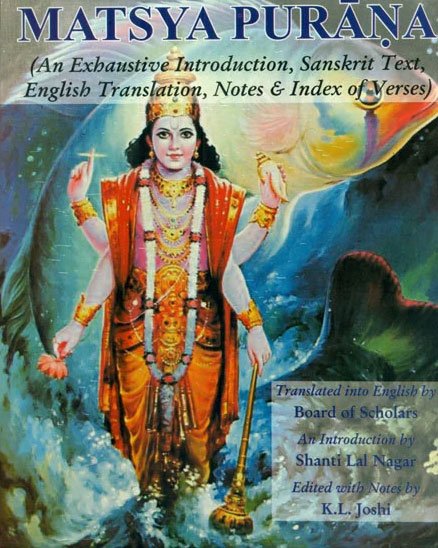The Matsya Purana (critical study)
by Kushal Kalita | 2018 | 74,766 words | ISBN-13: 9788171103058
This page relates ‘Madanadvadashi-vrata’ of the English study on the Matsya-purana: a Sanskrit text preserving ancient Indian traditions and legends written in over 14,000 metrical verses. In this study, the background and content of the Matsyapurana is outlined against the cultural history of ancient India in terms of religion, politics, geography and architectural aspects. It shows how the encyclopedic character causes the text to deal with almost all the aspects of human civilization.
Part 4.2f - Madanadvādaśī-vrata
The vrata of Madanadvādaśī also finds an important place in the Matsyapurāṇa. Though this vrata is described in the Digests like Kṛtyakalpataru, Kṛtyaratnākara, Hemādri’s work on vrata etc., among the Purāṇas, it is only the Matsyapurāṇa which gives its elaborate description. In the 7th Chapter of the Matsyapurāṇa, Diti, the mother of the Maruts asked Sage Vaśiṣṭha about some vrata which can remove her grief of her son’s destruction and carry happiness for her. Then Vaśiṣṭha advised Diti to observe Madanadvādaśīvrata. By observing it Diti regained her forty nine (49) sons and became liberated from her grief. This vrata is observed in the month of Caitra on the 12th day (dvādaśī) of bright fortnight (śuklapakṣa).[1] The observer of this vrata becomes liberated from all evils, gets worthy sons, prosperity and becomes equal with Viṣṇu.[2] This vrata also improves the man both physically and morally.[3]
On the 12th day of bright fortnight of Caitra the observer of Madanadvādaśīvrata should place an unbroken jar covering it with two white clothes and white sandal paste. That jar should be filled with different fruits and white rice.[4] After this a small plate of copper containg some fruits, gold, and molasses should be placed on the top of the jar.[5] An image of Madana is placed on some bananas above it. And to the left of it the image of Rati, made of sugar is placed.[6] After this the worship of Madana and Rati starts with the bathing of the two images with incense and water. And thereafter white flowers, rice, sesame should be offered. Then the aṅgapujā of lord Hari should be done with different mantras.[7] Various parts of the body of Keśava starting from the feet, then the legs, thighs, waist, stomach, breast, mouth, hands and head are worshipped uttering mantras. Thereafter offering sandal and incense prayer is sung accompanied by music glorifying Kāma and Keśava. On the following morning the jar should be given to a brāhmaṇa. After that the worshipper should feed a number of brāhmaṇas with devotion and take his own meal without salt.
Then uttering [the following prayer, the invited Brāhmaṇas are given gifts as dakṣiṇā]:
priyatāmatra bhagavān kāmarūpī janārdanaḥ/
hṛdaye sarvabhūtānāṃ ya ānandoˊbhidhīyate.[8]
This routine is followed for a complete year and at the beginning of the 13th month on the completion of the vrata a golden image of Rati is worshipped. Afterwards white sesamum mixed with clarified butter is offered into fire pronouncing the names of Madana. At the end of the vrata the priest and his consort are worshipped, feasted and offered with various gifts, viz., flower garlands and sugarcanes.[9] All the gifts are given as per the means of the devotee.
Although this vrata is not found to be performed at the present time, yet, it carries a high value from different aspects. It is the first vrata which is discussed in the Matsyapurāṇa and this is perfomed by a woman. Hence, preference is given to the woman through this vrata. At the end of the vrata it is said that the devotee can give gifts according to her means.[10] This shows the flexibility of the vrata by which a poor devotee also can perform it.
Footnotes and references:
[1]:
caitramāsi sitepakṣe dvādaśyām niyatavrataḥ/ Matsyapurāṇa, 7.10
[2]:
yaḥ kuryādvidhinānena madanadvādaśīmimām/ sa sarvapāpanirmuktaḥ prāpnoti harisāmyatām// ihaloke putrān saubhāgyaphalamaśnute/ Ibid., 7.27-28
[3]:
Cf., Matsyapurāṇa, Edited, H.H.Wilson, Vol.I, p. 33
[4]:
Matsyapurāṇa, 7.10-11
[5]:
nānābhakṣyasamopetaṃ sahiraṇyantu śaktitaḥ / tāmrapātraṃ guḍopetaṃ tasyopari niveśayet// Ibid.,7.12
[6]:
tasmādupari kāmantu kadalīdalasaṃsthitam/ kuryyādbhāryādvayopetaṃ ratiṃ tasya vāmataḥ// Ibid., 7.13
[7]:
Cf., Ibid., 7.16-18
[8]:
Ibid., 7.20
[9]:
viprebhyobhojanaṃ dadyād vittaśāṭhyaṃ vivarjayet/ ikṣudaṇḍānatho dadyāt puṣpamālāśca śaktitaḥ// Ibid., 7.26
[10]:
Ibid., 7.26
